PBS News, NBC News, NOVA PBS, National Geographic, and DW Documentary
PBS NewsHour full episode, Oct. 8, 2021
NBC News: Nightly News Full Broadcast – October 8th
NOVA PBS: Nikon Small World 2021 Photo Competition winners announced
From neurons to tick heads to louse claws, here are the top 10 images from the competition.
National Geographic: COVID-19 is linked to new diabetes cases—but long-term problems could be more severe
DW Documentary: Great apes – How intelligent are our closest relatives?, Can viruses be beneficial? and Extreme weather, rising sea levels, devastating floods – The global climate crisis
PBS NewsHour full episode, Oct. 8, 2021
Oct 8, 2021 PBS NewsHour
Friday on the NewsHour, employment numbers in the United States fall short of expectations as workers continue to leave their jobs in the wake of the pandemic. Then, the Nobel Peace Prize is awarded to news editors from Russia and the Philippines for their reporting in the face of political repression. And, David Brooks and Karen Tumulty consider the week in politics. WATCH TODAY’S SEGMENTS: News Wrap: Biden to send Trump records to Jan. 6 committee https://www.youtube.com/watch?v=HQdO7… Why so many U.S. workers quit their job during the pandemic https://www.youtube.com/watch?v=QNwfu… Why the Nobel Peace Prize was won by to 2 journalists https://www.youtube.com/watch?v=R1pNx… Fiona Hill reflects on Trump presidency, opportunity in U.S. https://www.youtube.com/watch?v=hZhSE… Brooks and Tumulty on debt ceiling, Jan. 6 investigation https://www.youtube.com/watch?v=JwWe6… Bill T. Jones’ new work explores collective American ‘we’ https://www.youtube.com/watch?v=9G9JR… Stream your PBS favorites with the PBS app: https://to.pbs.org/2Jb8twG Find more from PBS NewsHour at https://www.pbs.org/newshour Subscribe to our YouTube channel: https://bit.ly/2HfsCD6
https://www.youtube.com/watch?v=noP53Q-Uk-w
Nightly News Full Broadcast – October 8th
Oct 8, 2021 NBC News
U.S. added 194,000 jobs in September, unemployment rate down, two parents convicted in college admissions scandal trial, and combat medics unite after forming special connection a decade ago. 00:00 Intro 02:01 Major Jobs Setback 04:36 Mandate Battles 07:36 College Admissions Conviction 10:04 Biden – Trump Showdown 14:05 Travel Price Warning 18:28 Those Who Serve » Subscribe to NBC News: http://nbcnews.to/SubscribeToNBC » Watch more NBC video: http://bit.ly/MoreNBCNews
NOVA PBS: Nikon Small World 2021 Photo Competition winners announced
From neurons to tick heads to louse claws, here are the top 10 images from the competition.
BY SUKEE BENNETT MONDAY, SEPTEMBER 13, 2021 NOVA NEXT
The winning image of the Nikon Small World 2021 Photo Competition shows a southern live oak leaf’s trichomes, stomata, and vessels. Image credit: Jason Kirk, Baylor College of Medicine
The winners of the Nikon Small World Photomicrography Competition, which aims to showcase “the beauty and complexity of life as seen through the light microscope,” were announced today.
This is the 47th year of the photo competition, which is open to anyone with an interest in microscopy—the use of microscopes to view samples and objects—and photography. This year the contest received almost 1,900 entries from 88 countries. A panel of five judges* evaluated the entries for originality, informational content, technical proficiency, and visual impact, Nikon reported. The results of the sister video competition, Small World In Motion, were announced last month.
Here are this year’s top 10 images:
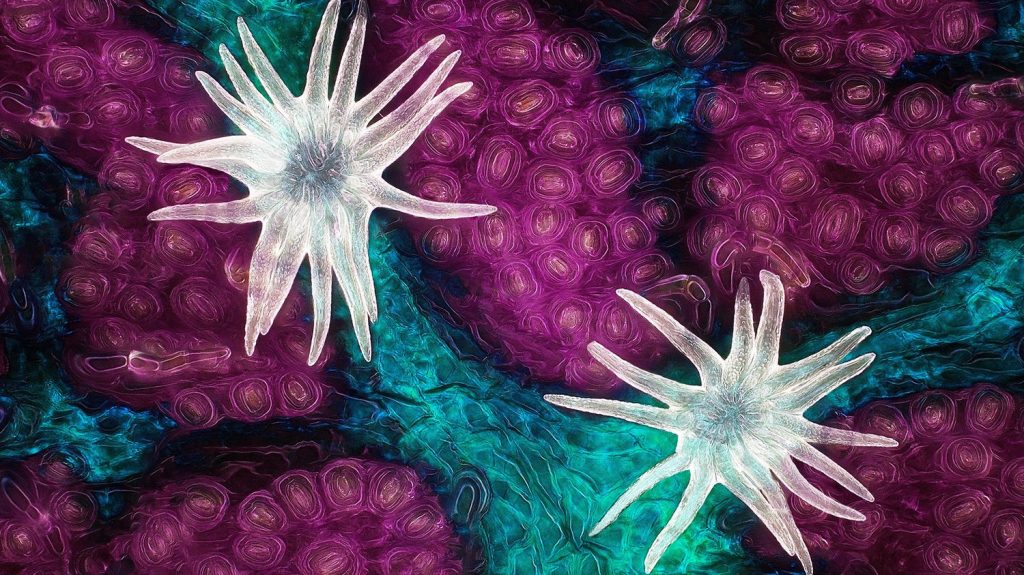 A southern live oak leaf’s trichomes, stomata, and vessels photographed by Jason Kirk, a professional imager and core director of Baylor College of Medicine’s Optical Imaging & Vital Microscopy Core. Kirk used a custom-made microscope system to take around 200 individual images of the leaf, which he stacked together to create this image, Nikon reports.
A southern live oak leaf’s trichomes, stomata, and vessels photographed by Jason Kirk, a professional imager and core director of Baylor College of Medicine’s Optical Imaging & Vital Microscopy Core. Kirk used a custom-made microscope system to take around 200 individual images of the leaf, which he stacked together to create this image, Nikon reports.
Trichomes, stomata, and vessels are all “essential to plant life,” Nikon writes. Trichomes, fine outgrowths that protect a plant from extreme weather and insects, are featured in white. “In purple, Jason highlights the stomata, small pores that regulate the flow of gases in a plant. Colored in cyan are the vessels that transport water throughout the leaf,” Nikon said in a statement.
- Networking neurons in microfluidic device
 Image credit: Esmeralda Paric and Holly Stefen, Dementia Research Centre, Macquarie University, New South Wales, Australia
Image credit: Esmeralda Paric and Holly Stefen, Dementia Research Centre, Macquarie University, New South Wales, Australia
This image is of a microfluidic device, which contains 300,000 networking neurons divided into two isolated populations (left and right) bridged by axons (center). The isolated populations were each treated with a unique virus, Nikon reports. The image was taken at 40X magnification by Esmeralda Paric and Holly Stefen of Macquarie University’s Dementia Research Centre in New South Wales, Australia, using fluorescence imaging, which uses high-intensity illumination to excite fluorescent molecules in a sample. “When a molecule absorbs photons, electrons are excited to a higher energy level,” Nikon writes. “As electrons ‘relax’ back to the ground-state, vibrational energy is lost and, as a result, the emission spectrum is shifted to longer wavelengths.”
- Rear leg, claw and respiratory trachea of a louse
 Image credit: Frank Reiser, Nassau Community College, New York
Image credit: Frank Reiser, Nassau Community College, New York
A rear leg, claw, and respiratory trachea of a louse, a wingless parasitic insect, at 5X magnification taken by Frank Reiser, a biologist at Nassau Community College in New York. Reiser used darkfield micrography, which “creates contrast in transparent unstained specimens” and “depends on controlling specimen illumination so that central light which normally passes through and around the specimen is blocked,” Nikon writes, and image stacking to produce this image.
- Embryonic rat neuron
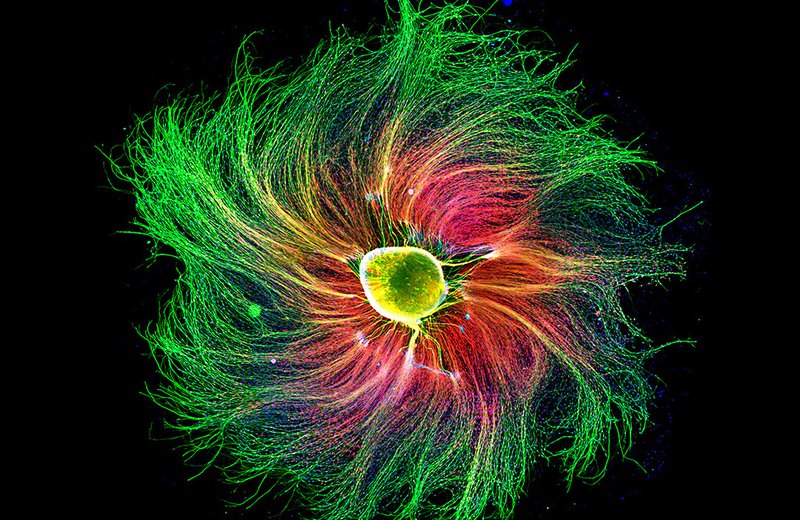 Image credit: Paula Diaz, Pontificia Universidad Católica de Chile, Santiago, Chile
Image credit: Paula Diaz, Pontificia Universidad Católica de Chile, Santiago, Chile
A sensory neuron from an embryonic rat taken by Paula Diaz, a physiologist at Pontificia Universidad Católica de Chile in Santiago, Chile. Diaz took the image at 10X magnification and used fluorescence imaging to produce it.
- Housefly proboscis
 Image credit: Oliver Dum, Medienbunker Produktion, Bendof, Rheinland Pfalz, Germany
Image credit: Oliver Dum, Medienbunker Produktion, Bendof, Rheinland Pfalz, Germany
A proboscis of a housefly (Musca domestica) taken by Oliver Dum of Medienbunker Produktion in Bendof, Rheinland Pfalz, Germany. Dum took the image at 40X magnification and assembled it using image stacking.
- Mouse brain vasculature
 Image credit: Dr. Andrea Tedeschi, Wexner Medical Center, Ohio State University
Image credit: Dr. Andrea Tedeschi, Wexner Medical Center, Ohio State University
3D vasculature of an adult mouse brain taken by Dr. Andrea Tedeschi of Ohio State University’s Wexner Medical Center in Columbus, Ohio. Tedeschi took the image at 10X magnification and used confocal imaging, which involves scanning a specimen to create extremely thin (down to 250 nanometer thickness) computer-generated optical sections using visible light, to create it.
SUPPORT PROVIDED BYLEARN MORE
- Tick head
 Image credit: Drs. Tong Zhang and Paul Stoodley, Ohio State University’s Campus Microscopy & Imaging Facility
Image credit: Drs. Tong Zhang and Paul Stoodley, Ohio State University’s Campus Microscopy & Imaging Facility
Head of a tick taken by Drs. Tong Zhang and Paul Stoodley of Ohio State University’s Campus Microscopy & Imaging Facility in Columbus, Ohio. Zhang and Stoodley took the image at 10X magnification and used confocal imaging to produce it.
- Mouse intestine
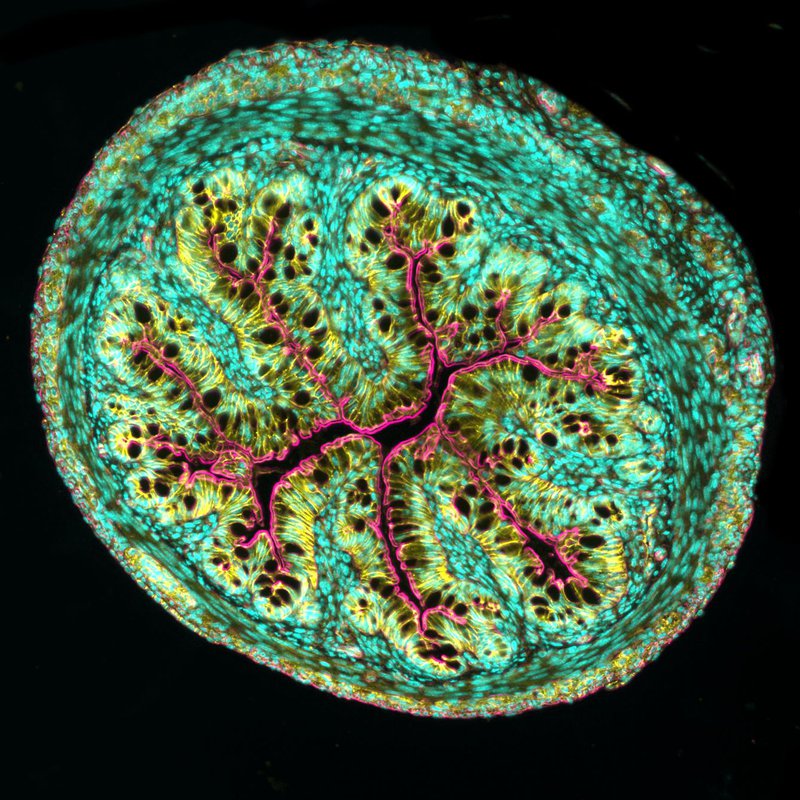 Image credit: Dr. Amy Engevik, Medical University of South Carolina
Image credit: Dr. Amy Engevik, Medical University of South Carolina
Cross section of a mouse intestine taken at 10X magnification using fluorescence imaging by Dr. Amy Engevik of the Medical University of South Carolina’s Department of Regenerative Medicine and Cell Biology in Charleston, South Carolina.
- Water flea
 Image credit: Jan van IJken, Jan van IJek Photography & Film, Amsterdam, the Netherlands
Image credit: Jan van IJken, Jan van IJek Photography & Film, Amsterdam, the Netherlands
A water flea (Daphnia) carrying embryos and ciliated vase-shaped protozoans called peritrichs taken at 10X magnification using image stacking and darkfield microscopy by Jan van IJken of Jan van IJek Photography & Film in Amsterdam, the Netherlands.
- Butterfly wing
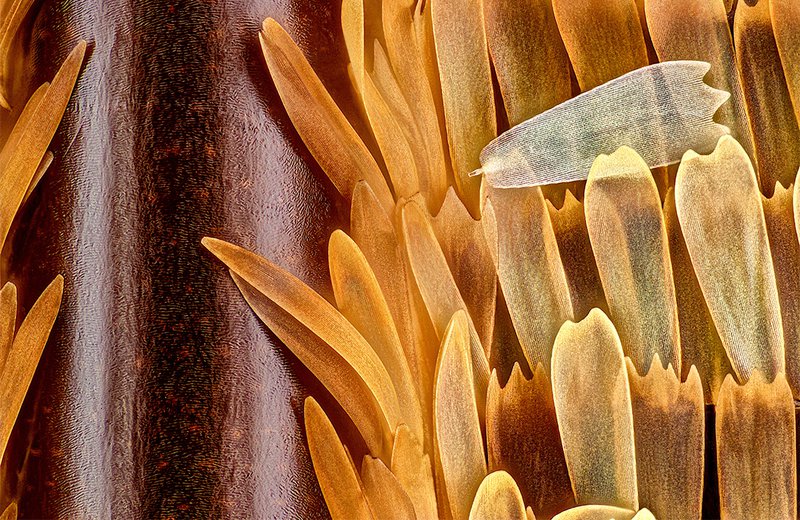 Image credit: Sebastien Malo, Saint Lys, Haute-Garonne, France
Image credit: Sebastien Malo, Saint Lys, Haute-Garonne, France
Vein and scales on a Morpho didius butterfly wing taken at 20X magnification using image stacking and reflected light photography by Sebastien Malo of Saint Lys, Haute-Garonne, France.
*NOVA Science Editor Robin Kazmier was a judge in this year’s competition.
For more information, please visit the following link:
https://www.pbs.org/wgbh/nova/article/nikon-small-world-photography-winners-2021-/
National Geographic
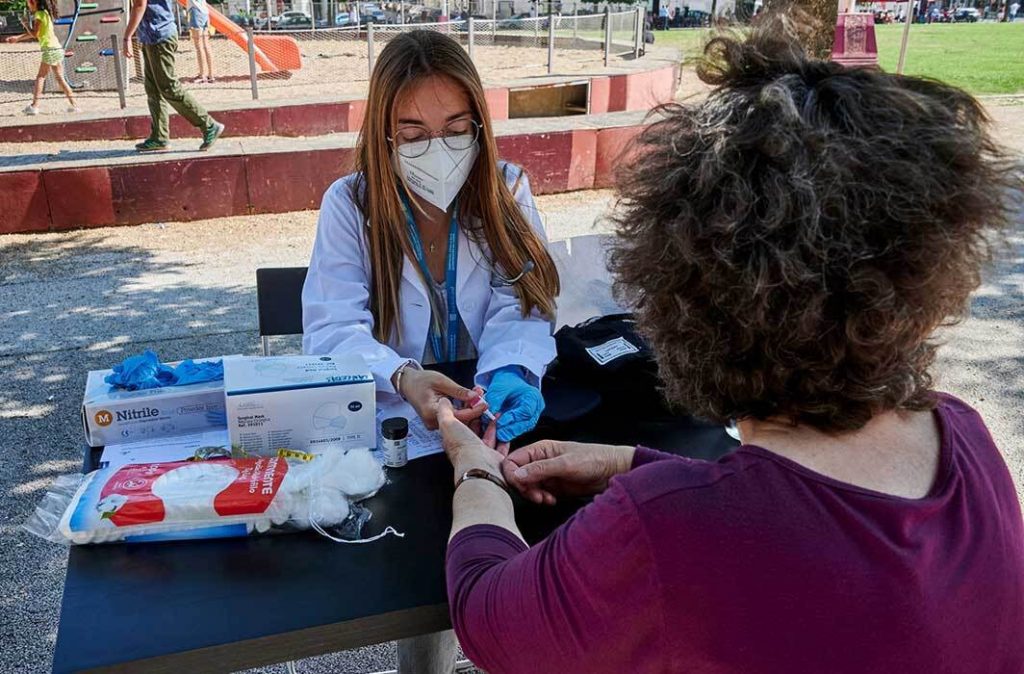 A medical student gives a woman a blood glucose test to check possible diabetes at a screening post in Alameda Dom Afonso Henriques during the COVID-19 pandemic on May 29, 2021 in Lisbon, Portugal.
A medical student gives a woman a blood glucose test to check possible diabetes at a screening post in Alameda Dom Afonso Henriques during the COVID-19 pandemic on May 29, 2021 in Lisbon, Portugal.
PHOTOGRAPH BY HORACIO VILLALOBOS, CORBIS VIA GETTY IMAGES
COVID-19 is linked to new diabetes cases—but long-term problems could be more severe
In addition to driving new cases of diabetes, the virus may be directly damaging the pancreas in ways that could lead to chronic inflammation and even cancer.
BYAMY MCKEEVER
PUBLISHED OCTOBER 8, 2021
Almost daily microbiologist Peter Jackson receives emails from people who recovered from COVID-19 only to discover that their health troubles have just begun.
Recently, a mother of two in her 30s wrote to the Stanford University professor to say that she now takes a slew of diabetes medications every day—even though she hadn’t been at risk for the disease before her coronavirus infection.
Experts have known since the beginning of the pandemic that having diabetes—a condition when the body doesn’t make enough insulin or use it well enough to counteract a rise in blood sugar—is a risk factor for more severe COVID-19 infections. But they have also long suspected that the inverse might be true as well. In May, Jackson published a study in the journal Cell Metabolism showing that SARS-CoV-2 infects cells in the pancreas that produce insulin and may even target and destroy them—suggesting that the virus may also cause diabetes. (Why scientists began investigating the link between COVID-19 and diabetes.)
“This is a real thing,” Jackson says of the complaints from newly diabetic people that have flooded his inbox. Although some experts argue that the condition is rare, Jackson says the data suggests that in 2020 as many as 100,000 people were diagnosed with an unexpected case of diabetes.
He is one of many scientists who worry there could be a new wave of diabetes patients who will have to monitor their blood sugar levels for the rest of their lives. But he and his colleagues are also concerned that the virus may be harming the pancreas in ways that may not be visible now but could one day have troubling implications for the organ itself and for the rest of the digestive system.
“This could be a pandemic in a pandemic,” says Paolo Fiorina, a professor of endocrinology at the University of Milan and lecturer at Harvard Medical School, who has also spearheaded investigations into the connection between COVID-19 and diabetes.
For more information, please visit the following link:
https://www.youtube.com/watch?v=F8HYkL6aZKE
Great apes – How intelligent are our closest relatives? | DW Documentary
Oct 7, 2021 DW Documentary
What can animals’ emotions tell us about ourselves? This documentary takes us on a fascinating journey into the lives of the great apes. Did you know that chimpanzees wage war? Not only that, but they also show compassion, engage in cooperative behavior, and value fairness and reciprocity. Chimpanzees reconcile after fights, and comfort each other. Chimpanzee communities also have customs and traditions that vary from tribe to tribe. All this begs the question: are things like morality and culture solely human achievements? This documentary takes us into one of the last great wildernesses of West Africa – the mountainous jungles of Nigeria – and shows footage of chimpanzees in the wild. What is the significance of the mysterious stone piles left by chimpanzees near trees or in hollows? Are they a form of religion? How intelligent are our closest relatives in the animal kingdom? In what kinds of societies did our common ancestors live? And where does the phenomenon of xenophobia come from? #documentary #freedocumentary #chimpanzees ______
https://www.youtube.com/watch?v=kYAx2MFji1M
Can viruses be beneficial? | DW Documentary
Aug 7, 2021 DW Documentary
Viruses can be fatal, but some viruses can in fact be life-sustaining. The SARS-CoV-2 virus has killed large numbers of people during the current pandemic. But humans wouldn’t exist without viruses. How can they benefit us? Viruses aren’t living beings, yet they have had a great influence on evolution. Some viral elements have embedded themselves into the human genome and reproduce along with us – so-called endogenous retroviruses. One type of virus helps form the placenta, for example, while other viruses attack harmful bacteria. Viruses also maintain balance in marine ecosystems, curbing the growth of algae and attacking bacteria that are harmful to sea animals. Soon, viruses may even replace antibiotics in fish farming. Thousands of viruses have already been sequenced, including Ebola, Zika and bird flu. Ebola is one of the deadliest viruses in the world, with a mortality rate of up to 90%. But experts see greater danger in the less deadly diseases like Spanish flu and COVID-19: Because they spread much further, they kill more people overall. Viruses can also be used to create vaccines. In Rome, the shell of a virus found in gorilla feces has been used as a vector for the COVID-19 vaccine, turning a pathogen into a life-saving drug. __
Extreme weather, rising sea levels, devastating floods – The global climate crisis | DW Documentary
Oct 5, 2021 DW Documentary
Extreme weather is occurring more frequently worldwide. Rising sea levels and heavy rain are causing devastating floods. Most researchers agree that these are the consequences of climate change. But what can we do to protect ourselves? In July 2021, the Ahr Valley in western Germany was hit by a flash flood after heavy rainfall. Over 100 people were killed, thousands of homes were severely damaged. Experts are calling it the ‘flood of the century’. Yet extreme weather events such as the Ahr Valley floods have become more frequent in recent years – not only in Germany but worldwide. Mozambique has been hit by devastating cyclones for the third year running. In Bangladesh, the monsoon season has become heavier and more unpredictable due to climate change. More and more land has been flooded as a result. At the same time, heavy storms that cause flooding and rising sea levels threaten the south of the country. Experts estimate that 30 per cent of Bangladesh will be permanently flooded in a few years, making millions of people climate refugees. Wealthy countries such as Germany are now investing billions in the battle against the floods. The Netherlands have long pioneered in flood management, building powerful pumping stations, ever higher dikes and flood barriers. None of these options are available to poor countries. All they can do, along with improving early flood warning systems, is to resettle the people affected. The film ‘Global Climate Crisis – How to Tackle the floods?’ shows the unequal fight against the consequences of climate change with examples from Germany, the Netherlands, Bangladesh, and Mozambique. #documentary #flooding #climatechange #extremeweather ______
Leave a Reply